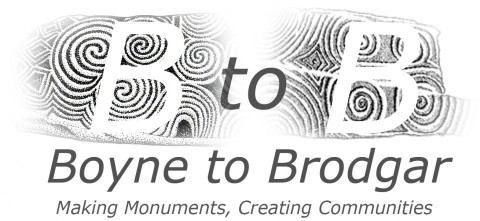The main period of Grooved Ware use during the first half of the third millennium clearly saw the construction and use of a range of non-megalithic and megalithic monuments in Ireland and Britain, and the re-use of some chamber tombs (Carlin and Cooney in press), along with the construction of increasingly monumental structures at the Ness of Brodgar in Orkney (Towers et al. 2015). The stone circles constructed at this time include Calanais on the Isle of Lewis. Long-distance contacts linking different parts of Ireland, Britain and Man – including inland Wessex, a major area of monument-building and ceremonial activity at the time – are evident at least at the beginning and the end of this period, if not throughout. The appearance, during the 25th century, of small numbers of Continental immigrants who used Beaker pottery and a variety of other novelties had a varying impact on monument-building activities. Much needs to be clarified, however:
- What is the relative chronology of the construction and use of henges/embanked enclosures, ‘square-in-circle’ timber structures, other timber circles (including the Newgrange pit-and-post circle), stone circles and complex timber enclosures? How were these monuments used, and was there a single coherent system of beliefs and practices that linked them? And how does the use of these monuments fit (in terms of chronology and meaning) with the reuse of pre-existing monuments, including passage tombs?
- Was this the main period of ‘rock art’ creation? If so, how does this practice relate to the overall Late Neolithic belief system/s and world view/s?
- What was the directionality and timing of the influence between the various regions – and were the inter-regional connections continuous between c. 3000 BC and c. 2500 BC, or sporadic? Did the use of stone (and timber) circles spread southwards from Orkney, along with the use of Grooved Ware, around the 30th century, as has been suggested elsewhere (Sheridan 2004 and see research theme 3, question 4)? Was the use of the ‘square in circle’ timber structures in Ireland influenced by contacts with Wessex towards the 26th century, or by earlier contacts with Scotland? And was the huge and impressive Ring of Brodgar in Orkney influenced by the ‘mega-henge’ at Avebury, and thus built during or after the 26th century BC?
- What was happening in the Isle of Man during this period? Clearly Man was not excluded from witnessing and participating in the Grooved Ware phenomenon, as is clear from the slate plaques with Grooved Ware/passage tomb designs found at Ronaldsway and Ballavarry (Darvill and Andrews 2014), but why do we find no evidence of the competitive conspicuous consumption that we see elsewhere at the time? Similarly, what kinds of monument (if any) were being used by other communities outside the Boyne Valley and Orkney at this time?

